#Live Corporate Training Software
Text
EduVSAT Best Live Classes Through Internet Software
Live streaming classrooms are virtual learning environments where students and teachers can interact and participate in real-time classes using streaming technology. In live streaming classrooms, students can attend classes remotely from any location with an internet connection.
Live streaming classrooms have gained popularity due to their convenience, flexibility, and accessibility. They have become particularly significant during times of widespread remote learning or when physical attendance is not possible or practical. Here are some key aspects of live streaming classrooms:
Real-time Instruction: In a live streaming classroom, teachers deliver their lessons or lectures through a live video stream. Students can see and hear the instructor in real time, replicating the experience of being in a physical classroom.
Interactive Communication: Live streaming classrooms often provide interactive features that allow students to actively participate in the class. Students can ask questions, engage in discussions, and provide feedback through chat or audio/video communication tools.
Virtual Platforms: Live streaming classrooms typically utilize virtual platforms or learning management systems (LMS) that support video streaming and provide additional features for educational purposes.
Accessible Learning Materials: Instructors can share course materials, such as lecture notes, presentations, or readings, through the virtual platform. Students can access these materials before or after the live session, providing them with supplementary resources to enhance their understanding.
Assessments and Evaluations: Live streaming classrooms can incorporate assessments and evaluations into the learning process. Teachers can administer quizzes, tests, or assignments in real time or using integrated online tools within the virtual platform.
Live streaming classroom software refers to specialized tools and platforms that facilitate the delivery of live classes or educational content over the internet. These software solutions provide features for video streaming, interactive communication, content sharing, and student engagement. Some key advantages include:
Flexibility and Accessibility: Live streaming classroom software allows learners to participate in classes from anywhere with an internet connection.
Interactive Learning: Live streaming classroom software provides interactive features that promote engagement and active participation.
Real-time Feedback and Clarification: With live streaming classroom software, students can receive immediate feedback from instructors during the class.
Scalability: Live streaming classroom software can accommodate a large number of participants simultaneously, making it suitable for both small and large classes.
Integration with Learning Management Systems (LMS): Many live streaming classroom software options integrate seamlessly with popular learning management systems.
Live Corporate Training Software:
Live corporate training software refers to specialized software tools or platforms designed to facilitate and enhance the delivery of training programs within corporate settings. This type of software is specifically tailored to meet the unique needs of corporate training, focusing on features that promote engagement, interactivity, and effective learning outcomes. Live corporate training software typically includes the following key components:
Content Delivery: The software allows trainers to deliver training materials, presentations, and multimedia content to participants in real-time. It supports features like screen sharing, slide presentations, video playback, etc.
Live Interaction: The software enables trainers to interact with participants and vice versa through various communication channels.
Collaboration and Group Activities: Many live corporate training software options provide features to facilitate group activities and collaboration among participants. This may include breakout rooms for small group discussions or virtual whiteboards.
Analytics and Reporting: Live corporate training software may offer analytics and reporting features to track participant engagement, performance, and completion rates. These analytics help trainers assess the effectiveness of the training program and identify areas for improvement.
Live Telemedicine Broadcast Software:
Live telemedicine broadcast software refers to specialized software solutions that enable healthcare providers to deliver real-time medical consultations, training sessions, or educational content remotely to a large audience. These software platforms support live streaming of medical services, allowing healthcare professionals to connect with patients, colleagues, or students in different locations. Here are some features commonly found in live telemedicine broadcast software:
The software provides high-quality video and audio communication capabilities for real-time consultations or training sessions. It allows healthcare professionals to interact with patients or participants, share medical information, and provide guidance remotely. Telemedicine broadcast software prioritizes patient privacy and data security. It ensures compliance with regulations, to protect patient information during live video sessions. Integration with EHR systems allows healthcare providers to access patient records during live telemedicine consultations, ensuring a seamless and comprehensive patient care experience. These software solutions aim to bridge the gap between healthcare providers and patients or participants in remote locations, allowing for efficient and secure delivery of medical services, consultations, or educational content.
Live Class Broadcasting Software:
These Lecture broadcasting software refers to specialized software solutions that facilitate the broadcasting of live classes or educational content to a large audience. These software platforms are designed to support real-time streaming of educational sessions, allowing educators to deliver live classes, webinars, or training sessions to students or participants remotely. The software enables educators to stream live video of their classes or presentations to participants. It supports high-quality video streaming with options for different camera angles, screen sharing, and multimedia integration.
Many live class broadcasting software options offer the ability to record sessions for later playback. This feature allows participants to review class content at their convenience and provides educators with the opportunity to create an archive of educational material. These software solutions cater to the needs of educators and provide them with the tools necessary to deliver engaging and interactive live classes to a remote audience.
V-SAT Broadcasting Software:
V-SAT (Very Small Aperture Terminal) broadcasting software refers to specialized software solutions used in satellite communications to broadcast content over a wide area. V-SAT technology utilizes small satellite dishes to transmit and receive data, enabling broadcasting of video, audio, and other multimedia content to a large number of users. While V-SAT systems primarily focus on data transmission, there are software components involved in managing and operating these systems.
V-SAT broadcasting systems typically include hub management software that provides control and monitoring capabilities for the satellite network. This software enables operators to configure, manage, and monitor the satellite terminals, monitor network performance, and troubleshoot issues. It allows for the delivery of various types of content, including video, audio, and data, to a wide audience. It supports encoding, modulation, and multiplexing of content to be transmitted via satellite.
V-SAT broadcasting software includes encryption and security measures to protect the transmitted content and ensure secure communication between the hub and the satellite terminals. It may integrate with back-end systems such as billing and customer management systems. This integration allows for seamless provisioning, billing, and management of the broadcasting services provided to customers.
Online classes through VSAT technology utilize satellite communication to deliver educational content to students in remote or underserved areas where internet connectivity is limited. VSAT technology allows for two-way communication, enabling live interactive sessions between teachers and students. The educational content, such as live video streams, instructional materials, and interactive elements, is transmitted from a central location to a satellite through a high-powered uplink antenna. The satellite receives the transmitted content and relays it to the VSAT terminals located at remote sites, such as schools or learning centers, using smaller receiving antennas. These VSAT terminals can be set up in classrooms or individual homes.
#Live Corporate Training Software#Online Classes through VSAT#Live encrypted streaming software#Live encrypted broadcast software#Live classes through internet software
0 notes
Text
Best software training institute in Bangalore |TechEntry
Launch your dream career at zero upfront fees with our hybrid training programs. We mold professionals who are career-ready.Learn fundamental coding skills alongside your academics and stand ahead of the crowd. Become a professional in programming, data structures and algorithms, web development, and more with our certification courses. Get a chance to intern with leading businesses and find your best-suited jobs with our placement support.

#Live project#software training institute Bangalore#corporate training#corporate trainer#courses on web designing
1 note
·
View note
Note
But antara you work with computers. Your livelihood isn't dependent on art. People whose livelihood depend on making artwork are saying that this is bad for business. Shouldn't their voice matter here? They aren't imperialists for not wanting corporates to train softwares on their stolen art. And how long till artists contribution are curtailed even more. It is a competitive market. This will jack the competition level upto a thousand + level!
I never called them imperialists. The art is not stolen from them. They still have the original copies. Intellectual property theft is a genuinely meaningless concept. I understand that they're worried, and I have sympathy. But the problem is in their fear they're getting in bed with reactionary forces. That will hurt more than artists, it hurts everyone in the way it makes copyright enforcement more draconian. I highlighted what that looked like in the last reblog of this.
sure, you can standpoint epistemology me into a heartless techbro – but I find this insistence on the special position of artists to be considered for protection from technological forces frankly self invested too. we didn't get this hysteria when grocery store cashiers got replaced by self checkout machines or skilled assembly line workers got replaced by KUKA industrial arms or bookkeepers by accounting software – is it because some workers and their work involve intrinsically more valuable skills than others? if not, shouldn't we ban any technology that can potentially replace a worker? protein folding and drug discovery by AI may save lives, but its taking jobs away from older researchers who did traditional work. should we all burn down washing machines so we can have laundrywomen again? or should we argue for stronger social security and reorganise our society to enjoy reduced working hours when jobs are automated and let people pursue work that they want without market pressures?
486 notes
·
View notes
Text
Jobs (HC)
Fandom: Blackstar Theater Starless
Pairing: No pairing.
Warning: None
Prompt: What if they had 'normal' lives where Starless never existed, and neither did the sketchy organizations behind the scenes? What non-sketchy careers would they pursue?
A/N: Assume older age for the younger characters; they're not in school/college anymore.
———————————————
Kei
Celebrity - Actor/Singer/Model (of course, lol)
CEO & Founder of a Corporation
Owner of a Movie Production House
Sotestu
Stockmarket Investor
Professional Poker Player
Detective/Private Investigator
Yakou
Scientist
Reporter
Professor (his class 99% female students, lol)
Yoshino
Chess Player
Owner of a small business (inn or restaurant - girls flock there just to see his cuteness)
Freelancer
Ginsei
Celebrity (Model/Actor)
General Manager in a big company
Scriptwriter
Gui
Parkourist
Skateboarder or Snowboarder
In short, Athlete
Kokuyou
Boxer
Captain in the military
Personal Trainer (A LOT of the women want him to train them)
Akira
Boyband Member
Bartender
Model
Sin
Author
CEO of a big company
Head of a Secret Service Agency
Takami
Detective
Politician
Businessman
Taiga
Streamer
Programmer/Developer
Runs a computer repair shop
Rindou
Model
PCP/Family Doctor
Pediatrician (all the moms loooove going to him because he takes care of their kids really well...yeah, let's go with that.)
Maica
CEO of a company
Fashion Blogger
Music Composer/Singer
Menou
Professional Mattress Tester
Applier for every clinical sleep study possible
Real Estate Agent
Sinju
Working for a non-profit
Caretaker in an elderly home (the grandmas and grandpas love him to death)
Freelancer
Nekome
Surgeon (would you trust him? XD)
Politician
Police Officer
Mokuren
Professional Food Taster
Dancer/Dance Teacher
Food Critic
Qu
Beauty Pageant/Model Trainer
Professional Makeup Artist
Fashion Designer
Zakuro
Controversial YouTuber
Politician
Therapist (would you trust him?)
Hari
Software Engineer
Founder of a business
Researcher at a large institute
Kasumi
Secret Agent for the government
Martial Art Instructor
Physical Therapist
Aogiri
Fashion Designer
Nurse Practitioner
Yoga Instructor (his calmness makes me think this😂)
Mizuki
Food Taster
Skateboarder
Bad Cop
Kongou
Professional Chef
Gym Trainer/Bodybuilder
Wrestler (of course lol)
Heath
Florist
Underground Rapper
Environmentalist
Ran
Skateboarder
Dog Trainer
Idol
Rico
Model
Personal Fashion Designer
Casting Director
Hinata
Basketball Player
Tattoo Artist
Gym Instructor
Unei
9 to 5 Office Employee
Manager in a small company
———————————————
➣ BlackStar Theater Starless Masterlists [1][2][3][4]
➣ Main Masterlist
#bsts#blackstar theater starless#bsts kei#bsts sotetsu#bsts yoshino#bsts yakou#bsts ginsei#bsts gui#bsts kokuyou#bsts akira#bsts sin#bsts takami#bsts taiga#bsts rindou#bsts maica#bsts nekome#bsts sinju#bsts menou#bsts mokuren#bsts qu#bsts hari#bsts zakuro#bsts aogiri#bsts kasumi#bsts mizuki#bsts kongou#bsts ran#bsts rico#bsts heath#bsts hinata
30 notes
·
View notes
Text
Family/Laugh: May 12 & 13 Prompts from @calaisreno
The exterior nowheres that Sherlock inhabits can be charted by his footfalls as he wends his way through the precincts of temporary cities. The silent drift of assimilating interior nowheres, however, seems to leave no traces, even as he feels unseen changes taking hold. His suspension in the January North of a darkness that persists until late morning, and then quickly returns in the afternoon, intensifies his perception that he lives in a shadow-world, a lone dark figure extracted from the frozen rain that curtains his days.
The patterns he seeks to capture as he hunts amidst the ones and zeros of cyberspace are likewise intangible – extended solitary vigils as his fingers command the keyboard to winnow through the tangle of codes – as well as tangible, of meetings with the technological mix of people here at Tallinn’s crossroads: software developers seeking the leading edge at corporate labs, security experts at NATO’s Cyber Defence Centre of Excellence, the underground hackers who traverse the landscape of the digital realm’s hollow earth. Both the intangible and the tangible are intense efforts to spy glimpses of Moriarty’s covert presence in the spaces between the ones and zeros, summoning up the networks and nodes of the intersecting spheres of finance, and energy, and communications, as made manifest in trafficking, and counterfeiting, and hijacking, across the physical and human worlds.
He’s accumulated an abundance of leads, some he’s near-certain he understands, and others he’s yet to decipher – but it’s enough to reveal to him his next move on the chessboard: St. Petersburg. He’ll take the train from Tallinn, without needing to step out for border control, which is handled en route. He’ll be leaving Estonia under a new identity; he hopes to keep Lukas Sigerson in his back pocket for later uses, but it’s time to make his presence difficult to trace: it's time to step away from Mycroft’s grid. He’s left seemingly inadvertent clues to allow Mycrofts’s people to (think that they’re) following him, along a pathway that connects the nefarious doings of Mexican cartels involved in establishing meth labs in Nigeria for the Asian market. Their pursuit of him will be turned to good account in dismantling that nexus, even when they realize he is elsewhere.
St. Petersburg is a hive of hacking activity, the physical site of the infamous Russian Business Network, which catered to the needs of cyber criminals. It’s not surprising that it is the city where Vladimir Putin lived, received his education, and joined the KGB, as an agent in its foreign intelligence wing, before tunneling his way to Moscow. Sherlock doesn’t believe that there are many degrees of separation between Moriarty and the dark internet of Putin’s hellscape.
He arrives at the end of Tallinn’s usefulness on a Friday evening. As he packs up his kit in the office space he’s made homebase through a courtesy loan in deference to his Norwegian technology credentials, some of the younger workers have swept him up into their murmurating flock as they celebrate the coming weekend in search of alcohol, bar food, and music. In London, Sherlock would have begged off such a request, were anyone intrepid enough to suggest it, and he would have been unperturbed at whatever anyone might think. But he’s not Sherlock, he’s Lukas, at least for a short while longer, and although his persona is reserved, businesslike and uninclined to make small talk, Lukas possesses an average quantity of affability; and remaining unobtrusive is best accomplished by being amidst the motions of others, rather than making himself conspicuous by setting himself off from the norms of sociality.
He did not, however, anticipate the karaoke session, which is putting a severe strain on the bonhomie he is channeling to Lukas, as it’s clear that he’s going to need to accede to accepting a turn in the spotlight, lest he put a damper on the good spirits of his companions. He nevertheless protests with a smile, holding out his hands, but any input he might have been able to exert on the decision-making disappears, when two of his impromptu friends conspire to tug him toward the microphone, explaining that all three of them will venture forth together, with a song they insist is dead simple to sing, and that the well-lubricated crowd will be delighted to join in with them in belting out the familiar refrain.
Which is how he finds himself being carried along within a punchy, melodic stream that turns out to be excruciating emotionally, as the verses unfurl. He listlessly despairs, marooned, a hollowed-out laugh echoing inside his head in response.
. . . When I'm lonely, well, I know I'm gonna be
I'm gonna be the man who's lonely without you
And when I'm dreamin', well, I know I'm gonna dream
I'm gonna dream about the time when I'm with you.
When I go out (when I go out), well, I know I'm gonna be
I'm gonna be the man who goes along with you
And when I come home (when I come home), I know I'm gonna be
I'm gonna be the man who comes back home with you
I'm gonna be the man who's comin' home with you . . .
He’s exasperated at the universe conspiring to keep him unsettled, to deny him the solace of alone protecting him. He fears that he is fated to have any social contact whatsoever somehow conjure home and reminders of John.
The song ends to raucous cheers, and the enthusiasm surges on, and he’s being importuned to name a new song of his own choice before being allowed to return to the table. He looks at the smiling faces helplessly, immobilized by the churning cacophony playing hide-and-seek inside his guts, incapable of conjuring up the simplest of answers. Undeterred, they jolly him along, prompting him to think of a film he’s recently seen, or club he’s been to, or a favorite television show. At the latter suggestion, his mind does slightly slip free, and there is John again, teasing Sherlock into watching another of his favorite shows, Sherlock pretending to be annoyed at being consigned to such a fate. He turns to the young people, and raises his voice to speak into the nearest person’s ear to be heard over the noisy crowd, and says with a question in his voice, Peaky Blinders? He seems to have pleased them, as they fiddle around to pull the selection, bouncing in high spirits and punching their fists into the air, as the music starts, a bell ringing out, and the slithering deep tones speaking of the edge of town, of secrets in the border fires, of a gathering storm -- and a tall handsome man, in a dusty black coat, with a red right hand.
As Sherlock listens to the song unspool, his mind wanders back to the show's themes, reminding him of a line of thought he’d been considering the last few days – that to focus singularly on Moriarty and faceless confederates is not quite the right way to conceptualize the dead man's web: that there must have also been family members in leading positions, positions of trust.
One of the deep divides between himself and Mycroft originated in Sherlock’s refusal in uni to agree to work for SIS. Mycroft knew that he would never be able to trust completely any of the professionals who worked for him – after all they are spies working for money. To be sure, he wanted Sherlock to sign on to be able to appropriate his intelligence, but even more compelling was the fact that never having to question the loyalty of a brother would have made him an asset par excellence. Mycroft considers getting what he wants to be an inviolable law of the universe, and Sherlock doesn't think his brother will ever be able to truly forgive him for the rejection . . . especially given Sherlock's devotion to the inferior endeavors of dedicating himself to a life of metropolitan crime-solving.
Family; family is what matters.
A Moriarty is gone; but there are other Moriarties yet to be unearthed.
........................................................
@calaisreno @totallysilvergirl @friday411 @peanitbear @original-welovethebeekeeper @helloliriels @a-victorian-girl @keirgreeneyes @starrla89 @naefelldaurk
@topsyturvy-turtely @lisbeth-kk @raina-at @jobooksncoffee @meetinginsamarra @solarmama-plantsareneat @bluebellofbakerstreet @dragonnan @safedistancefrombeingsmart @jolieblack
@msladysmith @ninasnakie @riversong912 @dapetty
.............................................................................
36 notes
·
View notes
Text
my thoughts on how to do Basically Kinda cel animation but cheap as fuck. strap in this is a long post and there are many swears PART 1
Really long intro
ok so I was animating my thing the other month right, and I was going to infodump on how I do cel animation without the right training from the comfort of my chaotic mess of an office. But I got into it and I was like "my god, I'm going to have surgery in a few months and my gofundme has accumulated dust, I can't be buying fucking $1/each cels and more paint". that got me thinking like....MOST people are probably like "wow I'm broke as shit I can't do this" even if they want to, but I think you can, so I took a couple weekends to hurl myself face first into seeing if I could do this - the version for if you're broke as fuck or don't want to spend money.
Obviously if you want something good quality AND you don't want to make this a struggle, splurge on good supplies like real cels and paint if you have the money. But if you don't or you just want to fuck around, this info dump is for you.
Disclaimer: I'm not a professional (if you can't already tell lol 👀👀👀) and I have no idea if this is what cal arts would approve of or whatever the shit but to be brutally honest, I also don't give a fuck, they're too busy fulfilling their role as the gatekeepers of the human-expression-to-corporate-tax-write-off pipeline to watch your heartfelt if low res artistic expression so come join me in this pit and let's just do whatever the fuck we want with whatever we got.
My goal is to give you ideas so you too can do the fucking thing. It's not gonna be Snow White. It's not gonna even be Steamboat Willie. That's fine. The point is to do the thing anyway and make some shit you wouldn't have tried otherwise. (And share it with me here on the internet bc I'm bored and depressed. If you feel like it) because sure you can go and pull up your 2d animation software and rig some shit up and blow anything I can do by hand out of the water in about 3 min flat but THATS NOT THE POINT IS IT THE POINT IS THAT YOU TOO WANT TO EXPERIENCE ART AS SUFFERING AND MAYBE ALSO UNDERSTAND THAT SOFTWARE DOESNT MAKE ART FORMS OBSOLETE.
Anyway let me just stow this soap box under the counter real quick.
There.
K So I'm gonna go through how I tackled this challenge - cheap ass cel animation - starting with prep, then the drawing steps, then getting the shit into some form where you can put all the frames together.
Prerequisite suggestion
This ramble assumes that you at least vaguely understand how drawing works and understand the basic idea of how animation works. How to animate overall - like the principals of animation- is a wee bit outside the scope of this post, in no small part because I know there are a BILLION people out there who understand those principles and execute them better than I do. I think I followed some of Aaron Blaise's videos to learn, but there are also other tutorials on YouTube. I also just learned from watching pencil tests and filming references of my long suffering friend in which i gave her instructions like "ok NOW put your hands on your hips dramatically in the direction of that rock". But yeah like I said the principals of animation themselves are better off taught by someone who isn't me (and I'm honestly still practicing).
Alright that's enough intro. Let's start with setup
FINALLY THE INGREDIENTS LIST
Most of the stuff in this ?tutorial? is really probably honestly laying around your house right now, especially if you live with any 50+ people who have ever had an office job. But I will talk about costs anyway in case you're starting from scratch. I found pretty much all of the stuff at Dollar Tree, and yeah, it's not an ideal place to go, but also this is a tutorial for if you're broke. And also unlike things that you have to repeatedly buy that cost you more per unit in the long run, most things you are using here are one time necessities, so you really are saving money. ....Now I'm in the US. If you're not in the US, I think there are also similar stores in other places....It'll be similar to something like if there's a shop that sells stuff for 1-2 euro or whatever. Things at dollar tree range from about 1-5 bucks, but I managed this with the $1.25 items (some were actually less than that but I lost track of my receipt).
You will need the following shit for part 1 of this vaguely educational series:
The smallest cheapest strand of fairy lights you can get. Mine were battery powered, doesn't really matter either way. If you can get white ones get white ones. (I could Not find white ones :/)*
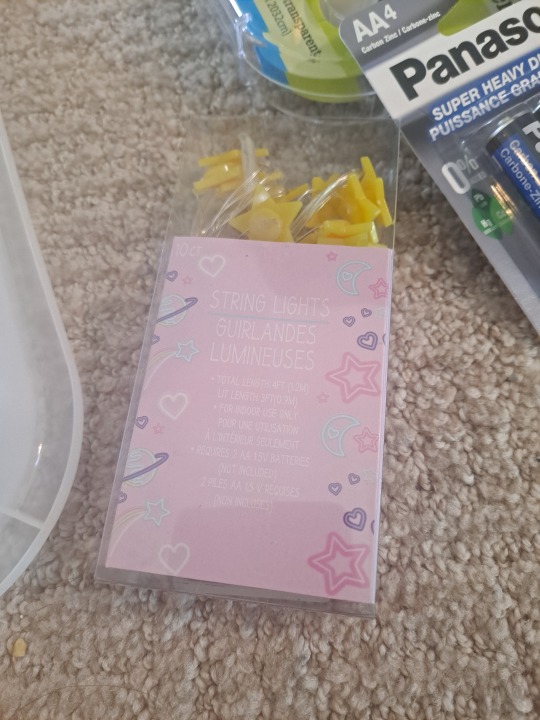
Batteries if they need batteries *
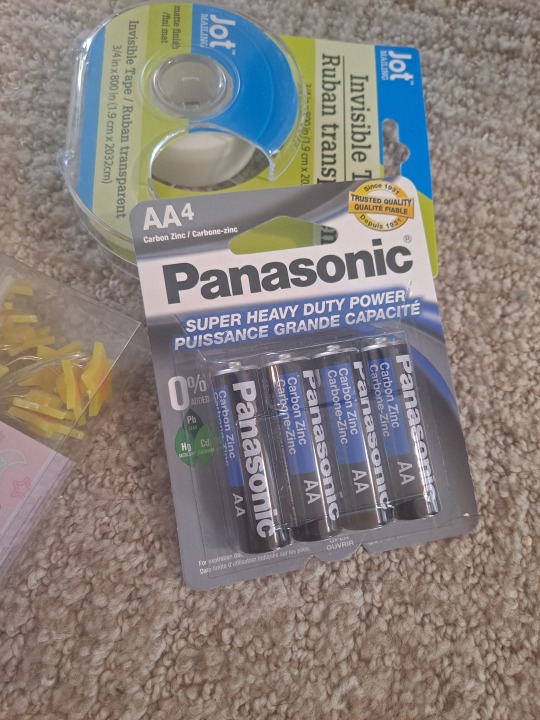
An 8.5x11 drawing pad (at the dollar store I got the 64 pg one)
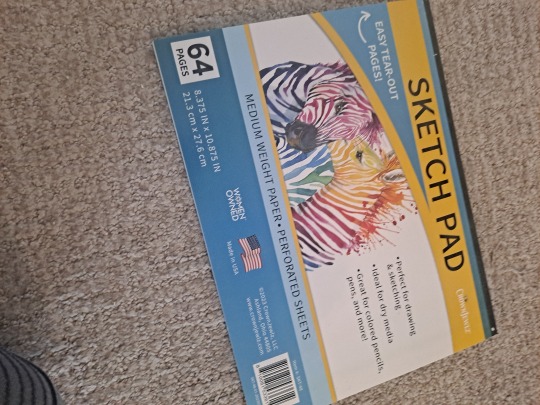
A translucent container with a flat bottom. I got a little 8x12 storage basket for this. You probably can't get anything big at the dollar store but try to get something with a bottom as close to the drawing pad size as possible (it's ok if it's a little smaller) *
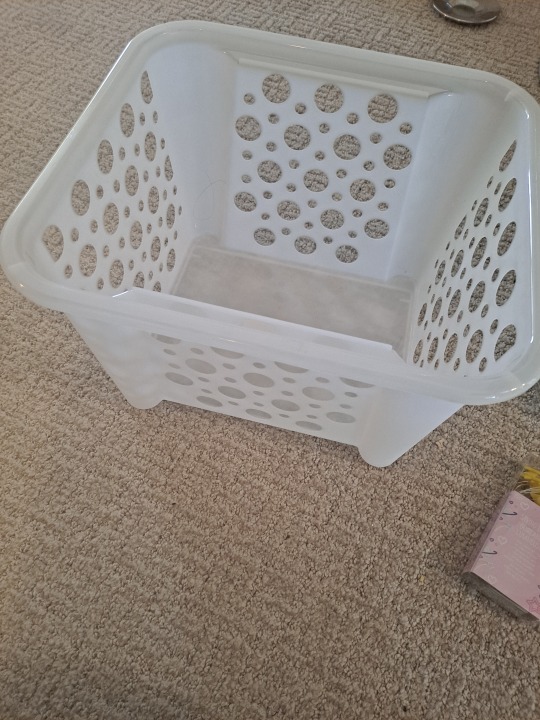
Scissors (or a knife/craft knife you don't mind destroying. You may want safety goggles if you don't have them. These also exist in dollar tree)**
Clear tape**

Something small and tube like. Maybe plastic straws. I actually used flagpoles from those tiny flags, you know the ones (ok these in the picture are NOT from dollar tree and i will provide excuses later on in this document. You could also use straws i think)
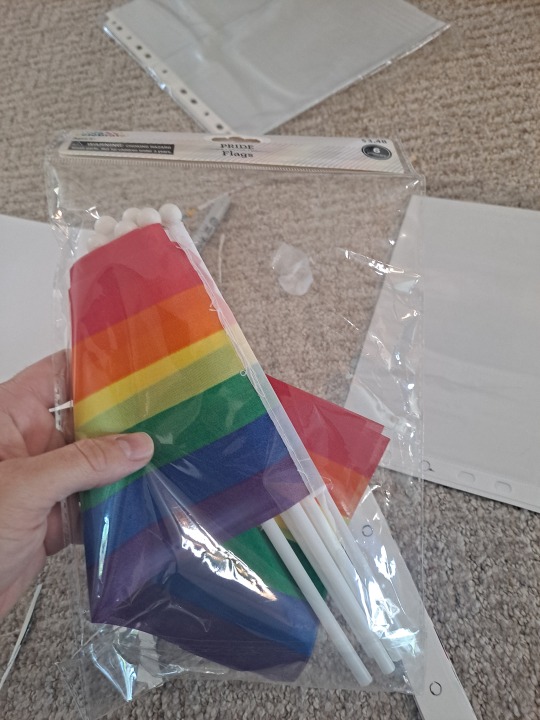
Hole punch
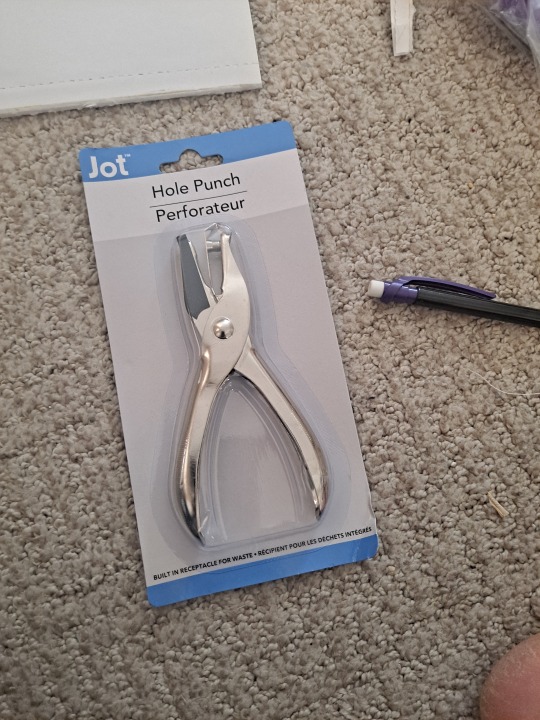
Super glue (or the strongest adhesive you can otherwise get if this isn't available to you)**

pencils (I don't know why I didn't take a picture of them but you're on the gay art website I feel like you've probably seen a pencil in your life)
sharpie (you'll use it more later but you might as well get it now)
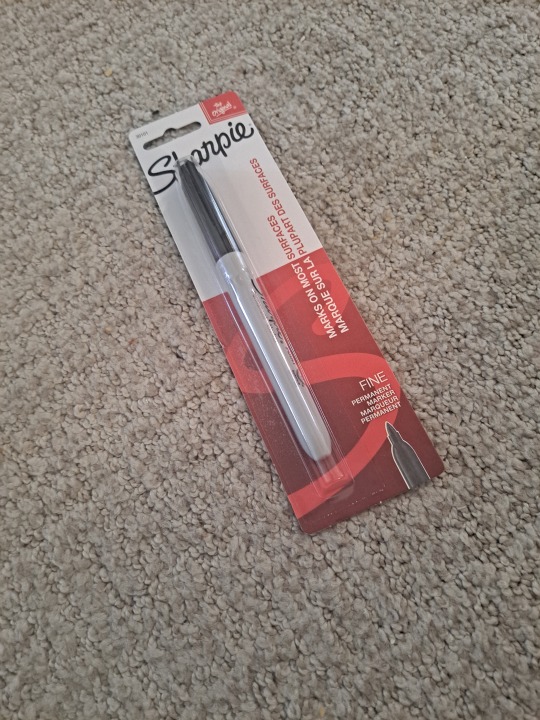
A pack of sheet protectors (you may or may not need more depending on how many frames you're doing but for now one will do but for this first part you only need one)
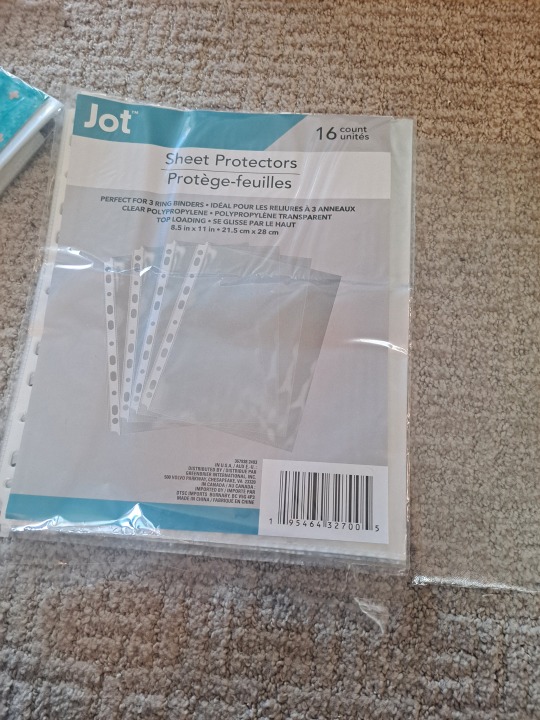
* this is part of an optional component but you WANT TO HAVE IT TRUST ME
**if you are REALLY not in the mood to buy these things and you don't need the tape/scissors for the above optional item, you can technically just go to FedEx and like make a cheap b/w self serve photocopy of something to avoid the employees yelling at you and then quickly go use their choppy thing and the tape and scissors they have laying around in the self serve area. They may have a hole punch too idk
And now FOR THE MAKING PART
First thing to make: substitute peg bar
Some things I'm doing here are optional, but the one that really isn't is the peg bar. That's the thing that keeps all your stuff lined up. Without this your frames are going to be moving all over the place and movements won't register the right way. It's got (if you couldn't guess) pegs on it. And these match up with the holes in your paper or cels.
This is a real peg bar
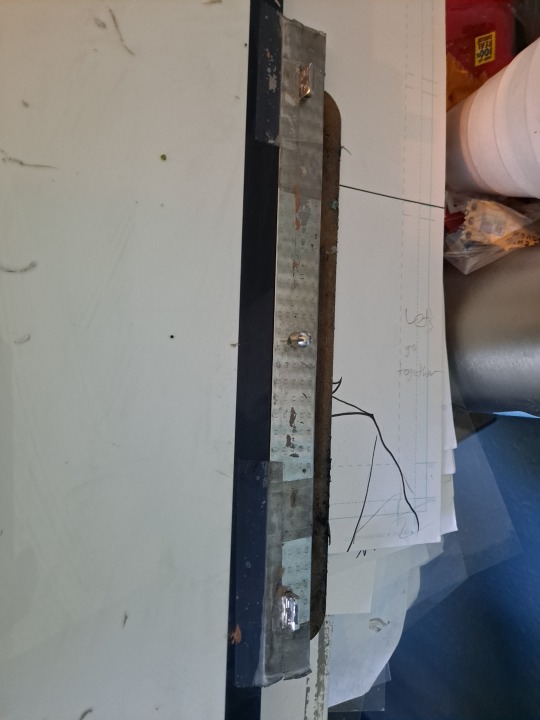
I think this is like 16-20 bucks if you buy it on Amazon, maybe a smidge cheaper if you go through someone else (I will discuss traditional animation supplies for when you're NOT broke as shit in another post). The problem is that this is for acme punched paper (notice how two of the holes are long). Yes it helps things register better, but we're going to be punching our own paper and a 700 dollar acme punch is NOT in our budget today.
There is a version of a peg bar you can get that fits normal hole punch holes. But this isn't the buy things the easy way tutorial, this is the broke as fuck tutorial. So we're going to be making this shit.
Steps to make the thing (I'm sorry about this list not being numbered apparently even when you fuck with the html directly you can't put images in a numbered list on this webbed site):
Ok first we need some cardboard or cardstock. Something sturdier than regular paper. OH GUESS WHAT WE HAVE THAT. If you don't have other stuff to use laying around, take all the backing cardstock off the drawing pad. Be careful to keep as much of the adhesive stuff left on the actual paper as possible.
We're going to cut that into strips. Keep them as straight as possible. They should be like 1/2-3/4 in wide.
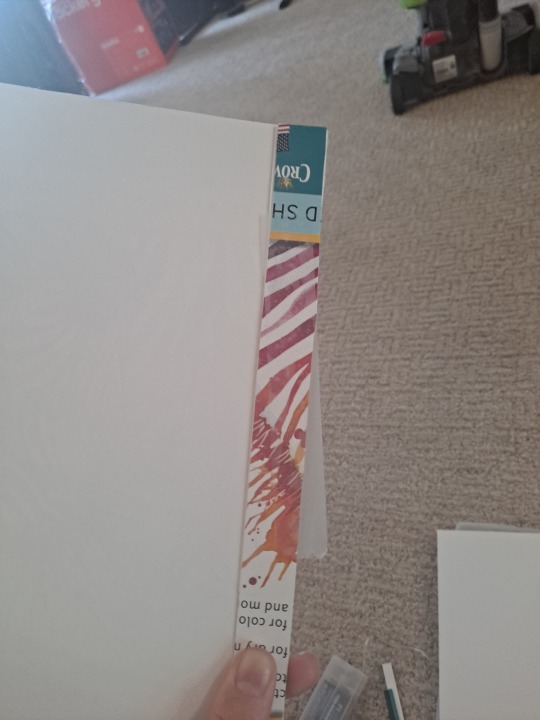
(You may want to skip ahead in the steps a bit to see how we're using this so when we use tape in this step you can avoid putting it where the pegs go. You don't have to but things will stick better) Stack them and tape them together as tightly as possible. This will be the bar part of the bar.

Take one of your page protectors and place it on the bar and try to center the middle hole on the bar. Trace that hole onto the bar and pick two others to trace (pick circle ones that fit entirely onto the bar).

Now we make the pegs. You will use the flags for this (or straws, see flags and note in the Ingredients TM list) So I actually had these pride flags from Walmart (please remember we are trying to stay dirt fucking cheap here, I promise I don't usually go to Walmart at all.) Bc my dollar tree doesn't have them yet, HOWEVER I KNOW THEY WILL BECAUSE IVE GOTTEN THEM BEFORE so technically by the time I finish writing this you will be able to get them there most likely. Now the great thing about cheap flags is they're cheap. That means they use shitty hollow plastic tubes as poles. That's great for us because we are going to snip off the ends and use them as pegs. You want to measure up a 1/2 inch from the bottom and cut them. Do this on 3 SEPARATE flags, because you want at least one perfectly flat end for each (that's likely the factory end, so keep track of which end that is). You can also use plastic straws for this probably, or paper sticks for thick lolly pops. The idea is whatever you use needs to fit the page protector holes.
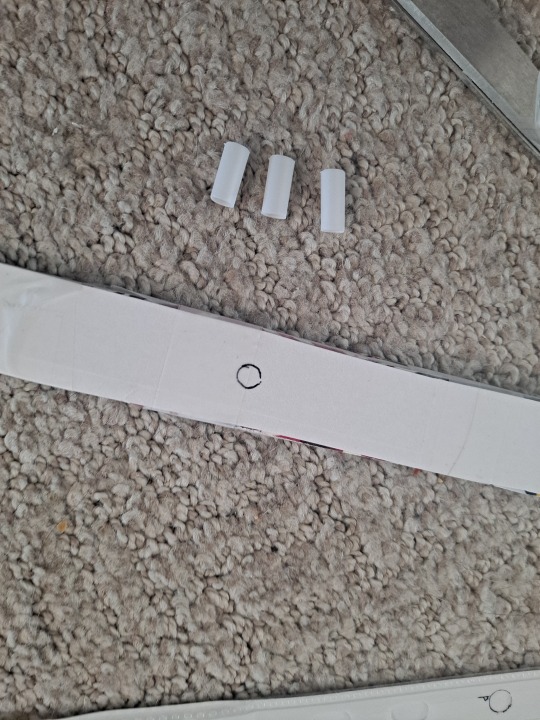
Take your super glue or other adhesive and put a little on the "pegs" and attach them (factory side down) to the bar where you marked the holes in step 4. (note that the pic shows that I taped both this and the thing you're making next to the leftover cardstock to keep it all together, which is an option but you don't have to if you like to suffer)
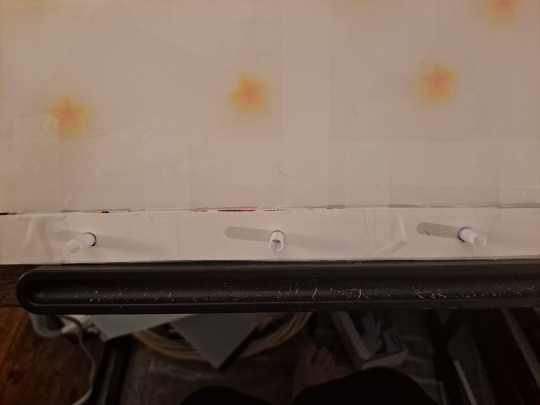
Let this dry while we work on the next part.
Second thing to make: "light box" (I use this term COMICALLY loosely. Optional but you will have an easier life if you have one)
This is the LED Light pad I use for animating. If you can afford like 30 bucks, just splurge and get one. It helps you cheat and see your previous pencil drawings under the current one so you can better draw the current frame. (And before you ask yes I know it looks like I dug it out of apocalypse aftermath rubble I will not be taking criticism at this time,,,,)
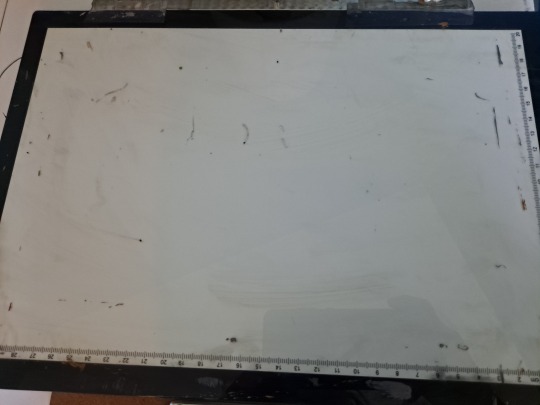
If you can't afford that, we're going to MacGyver together a little apparatus that works basically the same way. The "we have LED light box at home" if you will.
(I mean you can also just tape a peg bar to a window and go at it which is free but your arms are going to hurt drawing like that. You can also just get really good at page flipping while drawing. I am NOT good at that )
Steps to make the thing:
Remember how I made you get a plastic container with as flat of a bottom as possible? (It can be flat on the inside or outside bottom doesn't matter) We're going to mutilate that. Put on your safety glasses if you have them and you're scissor-cutting something that tends to crack rather than bend because the occasional plastic shard will fly off. Cut the sides off the container. It's probably easier with a knife but I was all about suffering. Try to get as much of the sides off as possible. It's ok to leave some of them if that's the side you'll have facing down. (For me my container had an annoying hard to cut rim on the bottom so I just decided to cut the sides off entirely and have that side down).
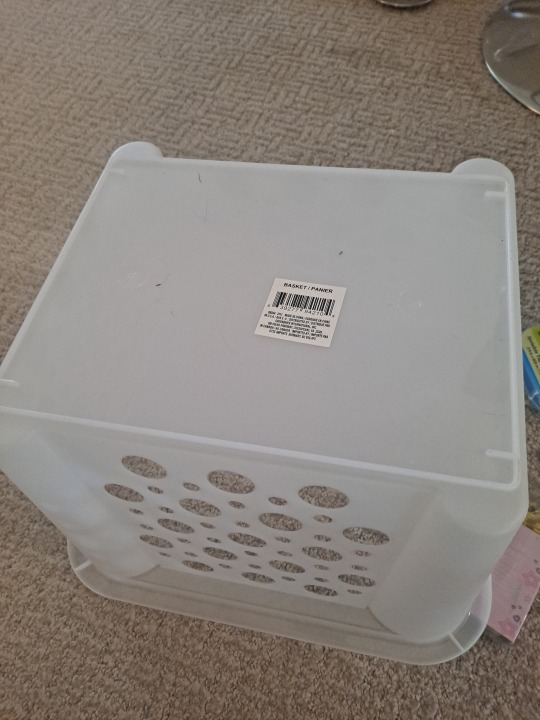

Take your fairy lights out and unwind them. If you have battery powered ones... Pry the cheap little battery compartment open (you can see there's a screw driver there so use one if you have it but this plastic is so cheap you'll probably be able to just bend the cover and pry it open and rotate it out of the way tbh) and stick the batteries in. We do this first to make sure the lights work before we waste time using them.
Cut a little notch in the side of your plastic piece where the wires can go.
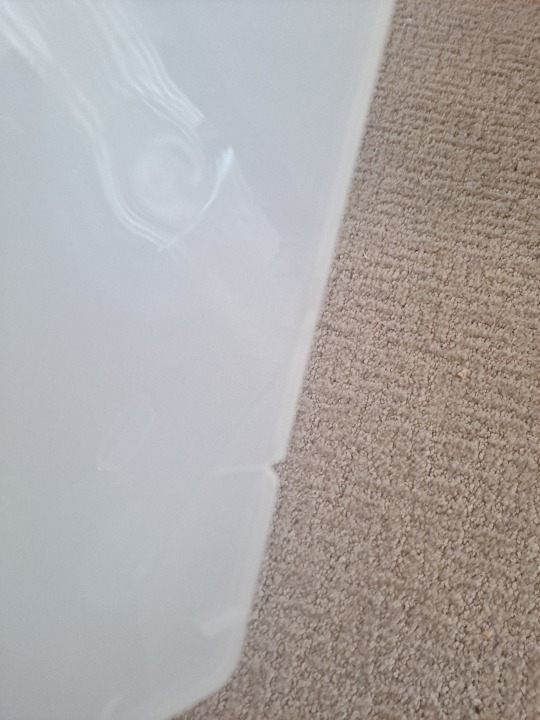
Flip your plastic piece so that the side facing you is the side you want facing down the rest of the time when you're actually drawing on this thing.
Feed the wire from the battery box (or coming off the plug if no battery box) through the little notch , with the battery box OUTSIDE the plastic area, and tape the wire in place.
Now arrange the strand so you have as even as possible a distribution of lights all over the plastic, and tape the wires down to hold the arrangement in place.
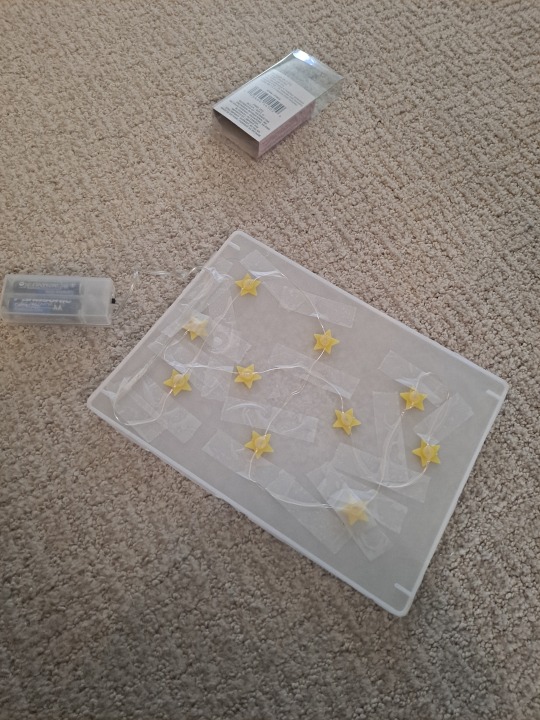
Flip it back over and switch it on. Voila shitty light box. Now you can't put a lot of PRESSURE on this but it'll do the job. You can see like 1-2 previous images through it too believe it or not. And this is with these horrible yellow lights I found, if you have brighter ones it should be more effective. (Now switch it off so you don't eat battery life)

Now let's get the paper ready
Now that the first part of your setup is done you need shit to do your pencil tests/preliminary animation on. (The thing you'll eventually trace onto the cel)
Take the paper you removed the backing from. We're going to mark and punch it. We'll be punching from the ADHESIVE/PERFORATED SIDE. This is important because it will help keep the pages and therefore holes aligned when we take the hole punch after it.
Here's how you go about it for the best result in my humble opinion:
If you made your peg bar as above, you've already removed the cardstock cover of your cheap drawing pad so go to step 2. If you haven't, then remove the cardstock cover/backing from your pad now. Try to keep the adhesive intact as much as you possibly can (basically you want to keep the pages from slipping when you eventually punch them so they need to stay in a neat little stack. If you're having trouble or you're having to use a different type of paper such as ink jet paper, you can probably also achieve this with binder clips in a pinch- is that what they're called? the black things? look like 90s butterfly hair things if you squint? Just make sure the paper is stacked evenly and the stack is held firmly together. )
Still trying to keep the adhesive holding the stack together as much as possible, carefully separate the paper into 2 or 3 smaller stacks. (ignore the hole markings in this picture I took it after I realized I needed to demonstrate this step)
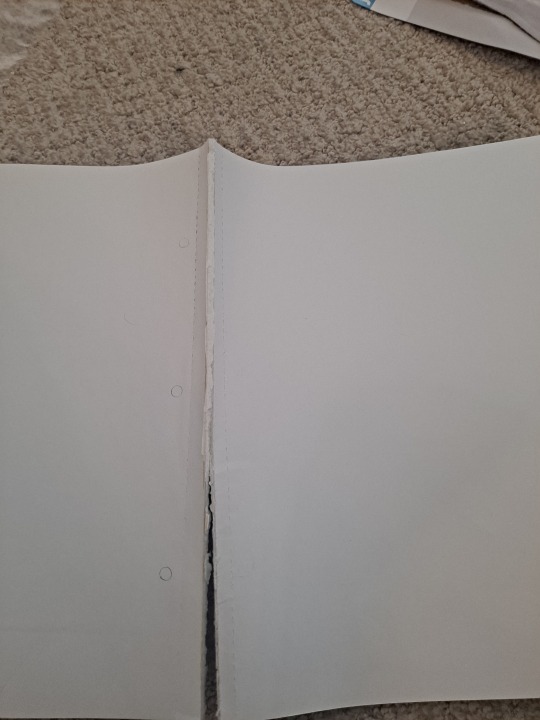
Take one stack and put one of the sheet protectors over it, lining the side with the holes up so that that edge is along the perforation in the drawing paper (if you're using a different type of paper than the dollar store pad, line the edge of the sheet protector up with the edge of the paper, but move it about 1/8th to 1/4th inch away from the edge. basically you don't want the holes right on the edge of the paper). Trace the holes onto the paper with a pen or pencil. (Note: if you're using a manufactured peg bar, use that to determine the hole placement instead of a sheet protector - it'll be easier to modify the holes in sheet protectors if necessary later).
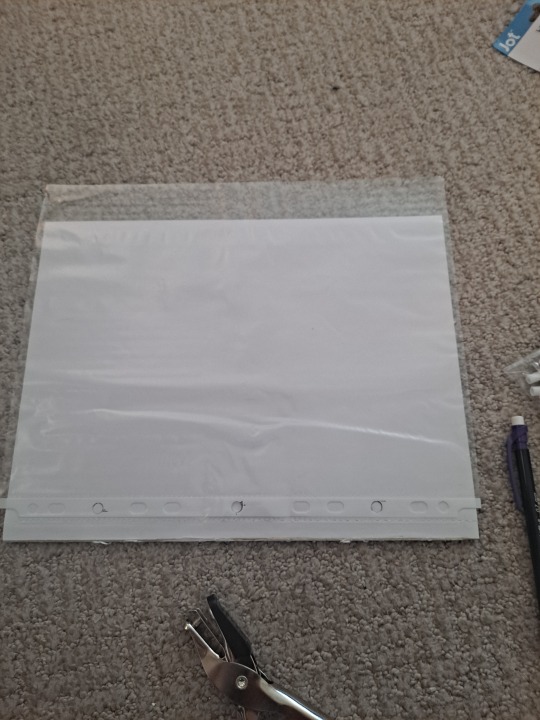
Carefully, keeping the stack of paper all lined up and together, punch each of your three holes with the hole punch. (The reason you made stacks is that do you really want to do this with each individual page? I didn't think so)

Ok Let's Try It Out!!
Alright here's a shot of me using this to draw some frames from my animation about some creepy deer (coming soon to a feature envy productions official tumblr near you). You take some paper and carefully place it on the pegs, sketch a key frame, and then place another sheet over that on the pegs, switch on the "light box" and sketch the next key frame, referencing the first one. (Oh and of course make sure you're drawing on the smooth side - not the side you taped the lights to). Like I said, this is definitely like. If you have no other options you might as well try it - You generally can see through about 3 sheets of paper in a dark room. At least the key areas. So you should be able to in between with this setup as well. Not great but hey! If you're on a strict budget, you can still do this, and it beats buying a bunch of expensive shit on Amazon. I'm pretty confident that most people have almost all of these items laying around their house like I said, but let's break it down - If you're like me and you animate at 24 fps but on 3s, that's an average of 8 frames per second. So for each pad of dollar store paper, you're getting about 8 seconds of animation (maybe more, maybe less). You can factor that in when deciding how many drawing pads to purchase (keep in mind if your backgrounds are very simple, you may be able to use the additional cardstock for this purpose as well instead of using up sheets of paper).

Stay tuned because we're not done yet!
Part 2 will be Inking and painting. (Note: on the day I'm writing this I have a placeholder post there, but if it's still a placeholder when you look, please keep checking, I will add the second part, I just didn't want someone to have to HUNT for it if you're looking at this from like a year from now) Yes ink and paint. You didn't think I was getting you all excited for a vine's worth of pencil tests were you? no we're doing the whole expensive process from pencils to final product. And I'm going to show you the cheapest way I could figure out.
#animation#traditional animation#well in the LOOSEST SENSE OF THE WORD#pencil test#tutorials#resources for if you're broke and want to animate anyway#i tried#Long post
24 notes
·
View notes
Text
Some Fortune 500 companies have begun testing software that can spot a deepfake of a real person in a live video call, following a spate of scams involving fraudulent job seekers who take a signing bonus and run.
The detection technology comes courtesy of GetReal Labs, a new company founded by Hany Farid, a UC-Berkeley professor and renowned authority on deepfakes and image and video manipulation.
GetReal Labs has developed a suite of tools for spotting images, audio, and video that are generated or manipulated either with artificial intelligence or manual methods. The company’s software can analyze the face in a video call and spot clues that may indicate it has been artificially generated and swapped onto the body of a real person.
“These aren’t hypothetical attacks, we’ve been hearing about it more and more,” Farid says. “In some cases, it seems they're trying to get intellectual property, infiltrating the company. In other cases, it seems purely financial, they just take the signing bonus.”
The FBI issued a warning in 2022 about deepfake job hunters who assume a real person’s identity during video calls. UK-based design and engineering firm Arup lost $25 million to a deepfake scammer posing as the company’s CFO. Romance scammers have also adopted the technology, swindling unsuspecting victims out of their savings.
Impersonating a real person on a live video feed is just one example of the kind of reality-melting trickery now possible thanks to AI. Large language models can convincingly mimic a real person in online chat, while short videos can be generated by tools like OpenAI’s Sora. Impressive AI advances in recent years have made deepfakery more convincing and more accessible. Free software makes it easy to hone deepfakery skills, and easily accessible AI tools can turn text prompts into realistic-looking photographs and videos.
But impersonating a person in a live video is a relatively new frontier. Creating this type of a deepfake typically involves using a mix of machine learning and face-tracking algorithms to seamlessly stitch a fake face onto a real one, allowing an interloper to control what an illicit likeness appears to say and do on screen.
Farid gave WIRED a demo of GetReal Labs’ technology. When shown a photograph of a corporate boardroom, the software analyzes the metadata associated with the image for signs that it has been modified. Several major AI companies including OpenAI, Google, and Meta now add digital signatures to AI-generated images, providing a solid way to confirm their inauthenticity. However, not all tools provide such stamps, and open source image generators can be configured not to. Metadata can also be easily manipulated.
GetReal Labs also uses several AI models, trained to distinguish between real and fake images and video, to flag likely forgeries. Other tools, a mix of AI and traditional forensics, help a user scrutinize an image for visual and physical discrepancies, for example highlighting shadows that point in different directions despite having the same light source, or that do not appear to match the object that cast them.
Lines drawn on different objects shown in perspective will also reveal if they converge on a common vanishing point, as would be the case in a real image.
Other startups that promise to flag deepfakes rely heavily on AI, but Farid says manual forensic analysis will also be crucial to flagging media manipulation. “Anybody who tells you that the solution to this problem is to just train an AI model is either a fool or a liar,” he says.
The need for a reality check extends beyond Fortune 500 firms. Deepfakes and manipulated media are already a major problem in the world of politics, an area Farid hopes his company’s technology could do real good. The WIRED Elections Project is tracking deepfakes used to boost or trash political candidates in elections in India, Indonesia, South Africa, and elsewhere. In the United States, a fake Joe Biden robocall was deployed last January in an effort to dissuade people from turning out to vote in the New Hampshire Presidential primary. Election-related “cheapfake” videos, edited in misleading ways, have gone viral of late, while a Russian disinformation unit has promoted an AI-manipulated clip disparaging Joe Biden.
Vincent Conitzer, a computer scientist at Carnegie Mellon University in Pittsburgh and coauthor of the book Moral AI, expects AI fakery to become more pervasive and more pernicious. That means, he says, there will be growing demand for tools designed to counter them.
“It is an arms race,” Conitzer says. “Even if you have something that right now is very effective at catching deepfakes, there's no guarantee that it will be effective at catching the next generation. A successful detector might even be used to train the next generation of deepfakes to evade that detector.”
GetReal Labs agrees it will be a constant battle to keep up with deepfakery. Ted Schlein, a cofounder of GetReal Labs and a veteran of the computer security industry, says it may not be long before everyone is confronted with some form of deepfake deception, as cybercrooks become more conversant with the technology and dream up ingenious new scams. He adds that manipulated media is a top topic of concern for many chief security officers. “Disinformation is the new malware,” Schlein says.
With significant potential to poison political discourse, Farid notes that media manipulation can be considered a more challenging problem. “I can reset my computer or buy a new one,” he says. “But the poisoning of the human mind is an existential threat to our democracy.”
13 notes
·
View notes
Text
green in the air
DannyMay2023 Day 22: Cryptid AU
title: green in the air
words: 2042
Summary: Ectoplasm is invasive and all consuming, and it shows in Amity Park's residents. (OC outsider POV)
Warnings: None!
Beta by: @probably-dead
~~~~~~
Ectoplasm is invasive. Once it’s in the air, in the water, on the ground, it is there to stay. Most places have such minor hauntings that it is inconsequential an amount, a ghost or two at most struggling to maintain its form and unable to spare any.
Amity Park isn’t most places. Unknowingly, Jack and Maddie Fenton had released more ectoplasm onto the human plane in the past year than in all of history - recorded and not - up until that point.
And, despite science’s belief otherwise, ectoplasm can absolutely be absorbed into the human body, live alongside living tissue, it just had never been present in this large an amount before, unable to be studied. It snuck into the humans in so many ways. In the air, merely being breathed in, growing and multiplying within the humans’ lungs. In the water for hydration, coating the pipes inside and seeping into the liquid. On the ground, sticking to clothes, sticking to the skin of children too young to walk, who’s hands always end up in their mouths.
Invisible, untraceable, even as it changed the humans, changed the definition of normal for all within Amity Park and Elmerton. Only a year since the portal had been opened by a teen’s half-death and already, outsiders could see the change.
Could see everyone here was just a little wrong.
~~~~~~
Joanne hefted the box out of the moving van, carefully avoiding her pet cats running around her feet as she moved up the stairs, depositing the box in her new bedroom. She wiped sweat from her brow, eyeing the mattress lying on the ground and debated collapsing onto it, making the bed frame be damned.
She sighed and instead moved to the window, looking at their new home.
Jo’s mom had been transferred to the Amity Park branch of the company she worked for and was expected to be here at least the next two years, updating software and training employees, unable to leave until corporate felt these employees knew the subject matter as well as the other locations did. Her mom had complained about it, worried about how poor the internet connection for the whole city must be, as this branch consistently had internet issues, thus the need for them to move on site.
At least Amity Park was pretty, she determined as she saw suburbia around her, trees and leaves dotting the area around them. It was still warm, the middle of July, and she had two weeks before she began her life as a sophomore at the high school. Jo wasn’t thrilled by this, though it wasn’t the first time her mom’s job had moved them. But two years here? That would have her moving again right before her senior year of high school, and who wants to be a new kid for their senior year of high school?
Maybe Amity would end up being nice and she could finish out her schooling here, convince her mom to stay an extra year.
She pulled herself from her thoughts, deciding her break was over and it was time to get more boxes from the van. Had she always owned so much stuff?
~~~~~~
The first two other students she met were a few days later, when she had ventured out to the mall by herself, with her mother’s blessing and her cell phone in hand.
The mall was… not what she’d expected. Something in her just said something was wrong, though it didn’t pinpoint what it was. It was like the beginning of a small muscle cramp, almost entirely ignored except for the nag in the back of her head. As she settled in line at one of the fast food stores, she realized what was wrong.
It was too quiet here. People were everywhere she looked, in crowds, in all ages, walking and chattering excitedly, yet their footsteps were too soft, like walking across carpet. Their voices didn’t echo like they should in a room like this.
An uncomfortable tingling in her fingertips that she shook away. It was just nerves, she was just somewhere new.
“Oh, I don’t think we’ve met before.” Someone said behind her and Jo nearly jumped clear through her skin. She whirled around, willing her heart to calm down. Two girls stood there - a pretty Latina girl and a blonde who was almost as pretty beside her, both with friendly smiles on their faces.
“Oh, uh, hi? I just moved here a few days ago.” Jo said, offering out her hand, which the darker skinned girl shook. A chill sent shivers down her back. Man, was this girl anemic? Her hand was so cold.
“I’m Paulina.” She said in greeting.
“I’m Star!” The blonde added, waving.
“I’m Joanne. Uh, Jo. I prefer Jo, though.”
Paulina tilted her head to the side curiously. It was a move she’d seen for years and it had never unnerved her but Paulina’s head went a little too far, her eyes taking too long between blinks. “It’s nice to meet you, Jo. Will you be attending Casper?”
“Yeah, tenth grade in a few weeks.”
“Oh! You’re in our grade, then!” Star said, grinning. Were human teeth normally that sharp? “Maybe you’ll be a part of the A-List.”
“A-List?”
“The best, prettiest, and most popular of Casper High.” Paulina explained, straightening her head back up. Jo had to resist the urge to swallow nervously. Why were these girls setting her so on edge? They were being perfectly friendly.
Whatever, they had just moved into territory Jo knew how to navigate. Popularity had always been a given for her and she knew how to say the right things. She shrugged, running her fingers boredly through her hair. “Hm, maybe. I just moved into Highland Park, do either of you know the area?”
Paulina smiled, no teeth, but the corners of her mouth went just a little too far up. “Oh, that’s where I’m from! You must have moved into the old Edgewood property.”
“Good guess.” Jo said, smiling back. The three had finished assessing each other and Jo slid in easily - rich and pretty was all it required.
“Oh, no, that’s just the only vacancy in Highland. There’s actually not a lot of available housing in Amity. People don’t leave here.”
That’s definitely a normal thing to say. “Ah, really?”
“Surprising, I know. But… we’re safe here. Protected.” Paulina said, Star nodding sagely beside her.
“Okay then…” Jo said, suddenly at a loss.
“Oh, you haven’t seen our biggest attractions, have you?” Paulina asked, understanding lighting up her eyes.
“What’s the biggest attraction?”
Paulina and Star glanced at each other and giggled. “You’ll know it when you see it. Trust me.”
“Uh. Okay?”
The two girls laughed again. “Here,” Paulina said, pulling a piece of crumpled paper and a pen from her purse, scribbling on it. “My number. Message me and I’ll introduce you to the rest of our group before school starts.”
Joanne took the paper, glancing at Paulina’s neat handwriting and nodding. “Sure, sounds good!”
“See you later, Jo!” Star said, and both girls waved at her. The waves were perfectly synced, each moving in tandem with the other. Again, discomfort in the back of her head. It just seemed… unnatural. But she said nothing of it, waving goodbye to the two.
If that was the popular crowd, she was almost afraid to see weird kids.
~~~~~~
When school started ten days later, Jo had successfully integrated with the A-List, becoming easy friends with the popular kids. They’d hung out several times and - while they still sometimes made the hair on Jo’s arms stand up - she had gotten used to the weird vibe they gave off. Joanne had lived in a lot of places, but the people here continued to give her a sense of wrongness.
“Oh, you never told us about your first encounter with our big attraction.” Paulina said as the group lounged around outside the school before class started.
“What is this attraction? I haven’t really seen anything memorable.” Jo said with a shrug.
“Wow, you’ve been here two weeks and not seen them yet?” Dash said, wonder in his eyes.
“Seen who?”
Dash opened his mouth to answer but Paulina slapped a perfectly manicured hand across his mouth. “You’ll see. They’re seen at school pretty often.”
Jo just rolled her eyes, convinced at this point she was being pranked. What attraction sometimes popped up at a school?
The warning bell rang and they gathered their things, standing up and chatting about nothing again.
A bump against her shoulder sent her books tumbling to the ground.
“Sorry!” A boy said and the feeling of wrongness she’d had since arriving here spiked again, worse than ever before, a knife to the base of her spine. She spun around, suddenly feeling like she shouldn’t have her back to whatever this kid was.
She was surprised to see what looked like a normal teenager, black hair and blue eyes on a tired face. Still, as normal as he looked, something was wrong with him. His eyes were too bright to be real, his hair didn’t seem to be moving the way it should with the wind. He smiled apologetically and too large teeth filled her vision. She jerked back, suddenly convinced he was about to strike like a snake. A hurt look passed across his face, apparently surprised by her intense need to get away.
“Are you okay?” He asked and his voice reminded her of an avalanche, of a boat slamming against an iceberg, each killing anyone who dared be too close.
“Fine.” She squeaked. He eyed her and then bent down, picking up the books she’d dropped as she continued to not move.
“I’m Danny,” he introduced, holding her books out to her. Her instincts snaked into her stomach, her throat, her mind, to not touch him, but she didn’t want to be rude so she grabbed at the stack. Her hand just barely brushed his and fear flooded her every sense, terrified tears coming to her eyes.
Whatever this boy was, it was not human. It was death and decay, it was destruction and damnation.
This time he jerked away from her, worry etched onto his features.
Predator. Her mind whispered to her as her heart beat so fast in terror it caused her pain.
“I’m gonna go now…” Danny said, turning and walking away.
Joanne did not stop staring at him as he left, frequently turning and glancing at her in confusion.
That was when she noticed the fact his chest was still. She did not see the rise and fall of breath, of life.
What was he?
~~~~~~
The answer would come in second period, when a metal man crashed through the wall, locked in tense combat with a white haired boy.
When the chill she’d felt earlier returned, when the feeling of imminent death struck her like a hammer and she screamed.
When ghosts were explained to her.
When she realized Danny Fenton was a dead teenager and the others around her… they had to be toeing the line between life and death, with their too sharp teeth and too wide smiles, with their soft footsteps and the way their voices refused to echo.
Was anyone in this city fully alive anymore?
~~~~~~
Joanne had no way of knowing that, no, they weren’t, death had touched all of Amity Park, the entire city too close to the veil but still far enough away.
Had no way of knowing the second she’d stepped out of that moving van, that death was infecting her too, that she’d never be able to leave without growing ill without the ectoplasm sustaining her living death, if she could even bring herself to try to leave, the air addictive.
No one in the city was fully alive, not anymore, not since the Fentons had punched a hole in reality. And she had lost her own claim to that idea - of being fully alive - the second the ectoplasm entered her lungs.
This was Amity Park’s normal.
This was her new normal.
Even if anyone from the outside could now tell she was a little bit wrong, too. A little too predatory, a little too quiet.
A little too dead.
#danny phantom#grace writes#dannymay2023#Day 22#Cryptid au#This one went so far into left field tbh#It is still within the cryptid au but just barely#amity park
112 notes
·
View notes
Text
i used to be a transcriptionist. i made decent money doing it - $1 per audio minute, which at an industry-average WPM works out to about $15 per hour, this in 2000s dollars. (mind you, my wpm is crazy, so i made more for my time.)
i had ADHD that wasn't medicated at the time and would get ready for work by brewing up a huge pot of coffee, letting it go lukewarm, and chugging it in one go. i don't recommend this approach but it worked. it was also hellish on my wrists, my audio processing disorder, etc. after a working day i'd have a hell of a time understanding anything anyone said to me on the phone.
i could pay rent with transcription in the 2000s, but rent was cheaper back then and transcription paid better. nowadays you're very lucky to see $.60 per audio minute without any formal qualifications (which are getting harder and harder to get), and the workflow has changed; everyone wants you to "edit" garbage machine translations and pay you with the fiction that you are "editing" them, where the reality is you have to do the exact same work but with an added layer of software wrangling for corporate compliance.
my great-aunt was a transcriptionist in the old days, when instead of VLC having a dial on it to adjust file speed she had to pay for a pedal that slowed down physical tapes. she paid for a mortgage with it, but that was in the 70s and 80s, when mortgages were cheaper (and rates were still at or near a dollar per audio minute, in less inflated dollars).
the existential threat everyone acknowledges to transcription is software, because everyone thinks software transcription is good. (it's not markedly more accurate than a well-trained 90s speech-to-text program, to be completely honest, and if you need a non-verbatim transcription - i.e. all the ums and ahs and doubling-back parts aren't left in - you're completely up shit creek.) the actual existential threat is outsourcing; the cost of living is simply lower in many areas of the anglophone world, people have less ability to take their ball and go home if offered insultingly low rates there. (this is not likely to remain the case forever, as average floor wages have increased by a factor of anywhere from 10 to 20 in anglophone south and southeast asia since 2000, and while they're very low by the standards of the global north, they're also on the order of a factor of 8 or so lower rather than a factor of 20 or 50.)
apparently the opportunities available to mostly housebound people with keyboard skills in america have declined such that the average such person, offered 60 cents a word to hammer out words for hours a day, can't reasonably take their ball and go home either. the competition used to be flipping burgers; now it's uber and grubhub, other gig work bullshit.
this is a long rambling story without much of a point. i miss having that job. i liked it, as shitty as it was. but i can't pay rent with it anymore, and it took too much out of me to be worth what it still pays
63 notes
·
View notes
Text
A few days after the release was discovered in June 2017, Stan met with Southcreek and the Oklahoma Corporation Commission, the state’s oil and gas regulatory agency. At the meeting, the company characterized the incident as a “small spill,” the Ledgerwoods later alleged in court. It was unclear how long the leak lasted, but the saltwater plume had already saturated the soil and killed 2 acres of vegetation by the time it broke the surface, according to state oil regulators.
Samples analyzed a month later by Oklahoma State University found that the soil’s concentration of chloride, which occurs in the type of salt water injected into the well, had risen to more than 12 times the state’s acceptable level and was “sufficiently high to reduce yield of even salt tolerant crops.”
Other tests showed that chloride levels in the family’s water well had spiked to more than five times what the Environmental Protection Agency deems safe. The tests didn’t look for other contaminants like heavy metals that are often left behind by the oil production process.
-
-
Don began traveling 30 miles round-trip to Walmart to buy bottled water. Stan and Tina’s steel pots rusted after being washed, and their 2-year-old great-niece’s skin became irritated and inflamed after repeatedly washing her hands while they potty-trained her. In a text message, the girl’s mother described her hands as looking like they had “a burn.”
-
-
As is common in American oil fields, property rights in this part of Oklahoma often create split estates, where one person owns the land while another owns the underlying minerals, such as oil and gas. The owner of the minerals has a right to drill, even if the landowner would prefer they didn’t.
-
-
But Oklahoma has more than 260,000 unplugged wells — behind only Texas — according to data from energy industry software firm Enverus. To plug and clean up the state’s wells could cost approximately $7.3 billion, according to an analysis of state records. Oklahoma has just $45 million in bonds.
The oil industry’s bonds are “shockingly inadequate,” said Peter Morgan, a Sierra Club senior attorney. “It’s clear that abandoning wells and leaving communities and taxpayers to foot the bill to clean them up is baked into the oil and gas industry business model.”
At the Capitol in Oklahoma City, which features repurposed oil derricks outside its main entrance, Republican state Rep. Brad Boles has tried for several years to address the shortfall. This year, he introduced a bill to create a tiered bonding system based on the number of wells a company operates, increasing the highest required bond to $150,000. [passed House, did not gt a vote in Senate]
-
-
A stream of trucks rumbled down the Ledgerwoods’ once-quiet gravel road as workers removed enough dirt to fill 750 dump trucks and pumped more than 71,000 gallons from the Ledgerwoods’ water well.
But the dangerous concentrations of chloride didn’t change, according to Fox Hollow’s report.
-
-
Progress in the lawsuit was short-lived. In November 2019, shortly after the Ledgerwoods’ attorney sent discovery requests to Wise Oil & Gas, the company filed in a Texas court for voluntary Chapter 7 bankruptcy — a full liquidation of its assets.
Company executives acknowledged they declared bankruptcy to avoid legal fees associated with the Ledgerwoods’ suit, according to court records.
-
-
But two months later, Mullin ruled against the Ledgerwoods. He disagreed that Wise Oil & Gas had entered bankruptcy to shed bad investments and dodge cleanup obligations. He blasted the Ledgerwoods for requesting sanctions against the Cocanoughers.
“Merely because the Ledgerwood Creditors have been damaged by the saltwater contamination, this does not provide them with an unfettered right to retaliate or lash out against unrelated and far-removed targets, such as the Cocanougher Sanction Targets,” Mullin wrote.
If the Ledgerwoods wanted to continue seeking damages against the Cocanoughers and their businesses, they would have to pay the oil company’s attorneys’ fees, about $107,000, Mullin ruled.
It's worth reading the whole article for a breakdown of exactly HOW a company that poisoned a family's well and farm got out of fixing it or paying compensation.
Not as relevant in this particular case, but uncapped out of service wells like this are a major source of methane, an even more potent greenhouse gas than CO2
9 notes
·
View notes
Text
Headcanons- Simon "Ghost" Riley
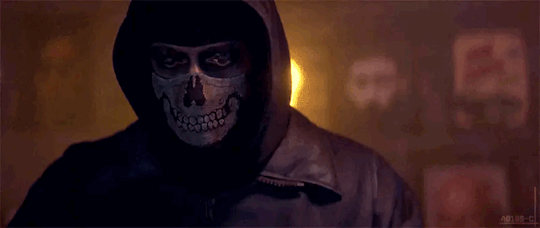
Sorry in advance, these are the least organized by FAR and the longest because Roach is my all time fav COD character so a lot of Simon's is just "this is how I would put roach in the story :)" and I also love tattoos and piercings so
Birthday December 22nd, 1993
Early life
The calculation used for his birth year was that he would have been about 29 during the events of MW2 (he enlisted at 17 in 2001, so in 2013 during MW2 he would’ve been about 29.) Therefore, 2022-1993 would be 29 years old during the MWII campaign.
Born in a small rural village outside of Manchester, but moved to the city when he was 10.
His mother, Meredith met his father, Paul at a music festival in Manchester and became pregnant shortly after.
She had Simon at 17 and married Paul, 23, at the urging of her devoutly Protestant parents once they found out she was pregnant.
His father was a construction worker, and was terribly abusive to his family, his mother never had a job or a way to escape because she was practically abandoned by her family after Simon’s birth.
Tommy was 4 years younger.
Undiagnosed autism spectrum disorder. Mostly manifests in masking, sensory issues, unwillingness to break schedules, etc.
I consider most of the Ghost comic canon, except moved up to the appropriate time.
Specialty Section: Roach
I can't wait for this all to need a rewrite in November
Grew up with Gary Roach Sanderson. Some headcanons about Gary include
Is not deaf, but both of his parents are so he almost exclusively communicated in BSL as a child.
Simon was one of the “weird kids” from a combination of his autism and abusive home life. The two got put together on a project once and were inseparable ever since.
Gary definitely always had more energy but Simon was the more outgoing of the two. Simon used to be a very outgoing, casual flirt to the point that Gary would have to drag him away from parties. (The personality of MW2 Ghost, very talkative.)
The two are like brothers. They enlisted at the same time.
Simon and Gary got into some minor teenage shenanigans, drinking, smoking at school, playing truant, etc. they both were definitely the sort of kids that went under the radar, nothing special.
Gary got his name Roach from escaping various explosions relatively unscathed, which led to the joke “only a nuke could kill Roach”.
Unfortunately, this was not the case. Roach lost both his left arm and leg in an IED explosion of which he was the only survivor. He retired from combat after this and now works remotely as a radio technician and software engineer for the SAS in Manchester.
Ghost genuinely considered retiring to help take care of Roach, but Roach wouldn’t let him. He knows Simon can’t really live in a civilian setting anymore.
Ghost lives with Roach when on leave and not doing other things. He the only person outside of the army he really considers a friend that knows his full story.
Brief and nonspecific timeline
As a private, was under Price’s US friend for a few missions. Put in a good word and had him and Gary sent to Price.
Met Price as a corporal, at the time he was charismatic, flirtatious, and generally outgoing after he got over his initial month or so of shyness. Was in Price’s squad for a mission along with Roach.
Went back and specially trained with prices US sniper friend. This is where Simon met Alex as well.
All of her Snipers got names based on “pest animals” (affectionately named “Pest Patrol” or “The Critter Corps” by graduates and Price.)
Gary got Roach for being able to bounce back from any explosion
Alex got Cotton Mouth because he casually picked one up and broke its neck during training once
Simon got the name “Possum” because he was incredibly skilled at “playing possum” or playing dead. Survived multiple really tight missions for his ability to blend in with corpses.
Went to a different squad, gains his Lieutenant rank
Roba happens, Ghost is born.
Captain Price pulls a lot of strings for Simon to make "the Ghost" a tenable position. This makes Price a lot of enemies out of higher-ups but he doesn’t give a damn.
Ghost and Roach are put into a squad together not with price. Work together for three or so years before the IED that wounds Roach.
Roach retires. Ghost bounces around positions because he’s legally “an asset” and not a man anymore.
Task force 141. Knows Gaz for about a year before he meets Soap in Las Almas.
General
He is triggered by Christmas and the holiday season, he found his family massacred on his birthday so neither Christmas or his Birthday are a positive association anymore.
The only person who’s given him a birthday or Christmas present since the massacre is Gaz, which didn’t upset Ghost like he thought it would. Mostly because Gaz didn’t know and Ghost couldn’t have expected him to.
Does not have any technology besides a cellphone and a computer he is required to for his job. The only three non-work related numbers in his phone are his tattoo artist/piercer, Roach, and his therapist
He genuinely enjoys gardening and baking but doesn’t do them frequently because of his life status.
Has a terrible, terrible, terrible sweet tooth, when he can get away with it. When no one is around this man is putting 5 heaping tablespoons of sugar in his tea, but no milk. Never milk.
Doesn’t like hard or sour candy, but does enjoy chocolate and biscuits.
He can, and will, and frequently does, eat all three meals in one sitting. He will eat 400 grams of protein in 4,000 calories in 20 minutes. He eats alone in his room because this shit terrifies people.
Endothermic body build, he’s built like a rugby player. His musculature is not “lean and mean” he is built like a discus thrower.
VENUS DIMPLES
When in public only wears a black surgical mask so as not to frighten others
It’s specifically to cover his Glasgow smile and lip scarring, which is prominent on his lower face
Jeans, t-shirts, hoodies, trainers, the occasional football-themed jersey or cap, nothing special
He has a fake civilian identity that not even Price knows the details of for anonymity's sake.
Has a full sleeve of tattoos and also a patchwork arm sleeve
He's actually famous in the Manchester tattoo scene as a lot of apprentices' first human canvas, under his fake civilian name of course.
Originally he got the war sleeve after his first deployment but went back after he became Ghost to get a tattoo over Roba’s name that was burned into him
The first tattoo artist asked him what tattoos he wanted on the wall and he said “All of 'em.”
His current tattoo artist is a scarification expert, she helped him design a piece to cover Roba’s name on his left hip, it’s a memorial piece to his family with the names “Merideth, Tommy, Beth, and Joey” held on a scroll by an Angel with the massacre date in Roman numerals
He continues to go back to this artist whenever he wants new ink, she is also his piercer. He does not care about his body and the ink on it, so she tries to schedule apprentices with him as their first because he can sit well/is not picky about his ink.
She sends him various pieces of body jewelry for his piercings at random under the guise of “let me know how this goes, wanna know if I can recommend it” etc but it’s really because she cares about him but also knows he won’t let her get him gifts for no reason.
A massive picture of his pierced nipple is in her shop as an example of her work
Has a shitton of piercings including but not limited to:
Quadruple lopes
Two conch
Rooks
Helix
Flats
Industrial (left only)
Bridge (taken out, since healed)
Tongue
Smiley
Lower lip (taken out, since healed)
He’s missing his left nipple, so he has both a vertical and horizontal nipple piercing on his right
4 Jacob’s ladder
Prince Albert's
Ghost wanted a married life and a family before Roba but does not anymore. He intends on dying in the field, he does not think about kids or retirement or alternative careers or dating. He loved Joseph and Tommy and Beth and his mum with all his heart and was a little jealous of the happy companionship they'd found for themselves, he stopped wanting it when he realized how quickly it could be taken away.
Typically avoids attachments because he knows how “loose ends” can end up harming loved ones. He has failed at this, very very very badly.
Ghosts most toxic trait is that he is falsely cynical. He will tell himself til he's blue in the face that he doesn't really care, it doesn't really matter, he doesn't really deserve love, that it's just not important when in reality he cares deeply. Caring is a liability so he tries very hard to cut that part of his brain out, he works out, he doesn't socialize, he avoids attachments because he is convinced he will ruin it for others. He doesn't even know what it is, until it's too late, just like how it took Johnny in Las Almas almost dying for him to open up to him.
Talents, special bonds, ETC
Trained to be a butcher in high school, before he and Roach joined the army. He retained his butchering and knife skills from this time.
Phenomenal aim, he can throw even the least aerodynamic thing and it will hit it's target.
He is a great baker, but a terrible cook besides grilling. No one knows its him, but he will leave trays of fresh baked goods in base rec-rooms.
Surprisingly, he is the softest on recruits when they mess up. He has an uncannily calm ability to diffuse most any situation and turn it into a learning experience, he also will not tell Price if he doesn't think it's that bad.
The inverse of this is if it's bad, his explosion about it is fucking bad.
Kids gravitate towards him and when push comes to shove he is great with kids. He is not terribly comfortable around children but kids love him. Its bittersweet because they remind him of Joey.
Is incredibly close with both Gaz and Soap but in different ways. He sees them both as reflections of him and Roach. As much shit as he gives them, he could not see himself without Gaz's quiet and calm understanding helping him remember how to be human or Soap's loud and explosive personality helping him remember just what being alive feels like.
Price may see Ghost as an equal, but Ghost does not see Price as one, he considers Price very far above him in every possible way. He does not know what Price sees in him.
#navigation -> headcanon tag#simon ghost riley#cod mwii#ghost mwii#gary roach sanderson cod#roach cod
46 notes
·
View notes
Text
On art and literature, and why it's not just "content"
Forgive me in advance for the incoming salt, but this is a rant I've been sitting on for ages. A tweet I saw* only cemented my need for the aforementioned rant, so here we are.
A bit of context first. I worked at a bullshit, huge corporation for almost 6 years; after that, I've moved on to a corporation that's way smaller and involves some actual work rather than bullshitting for 5 days a week, but it's still a corporation. That's a background experience I'll be relying on, mixed with observations of the absolute hellhole that LinkedIn is, with a sprinkle of mainstream media attitude. For the sake of clarity, I usually refer to art and literature as "art", but I'll be using art&lit in the post. With that out of the way, LET'S DIVE IN.
If there's one thing that's aplenty in every corporation, it's the amount of self-affirmative spam you receive every day. Department status updates, newsletters no one reads, trainings and videos to watch, and so on, and so forth. And it is, regardless of the corp and the type of spam, called "content". It's an apt name for it, because it's neither art, nor anything useful. Just a barrage of words some poor soul had to put together. Oh, I'm sorry, not a poor soul. A content creator.
I can say I'm a content creator at my day job. I write software documentation and manuals. It requires some thought and some effort, it's not a bullshit job I could ignore without any negative consequences to me or the company or the world at large. But it's not art I create there. It's content. It's got no artistic value whatsoever except maybe for explaining concepts in an easy-to-understand way. The companies themselves have got no qualms about calling that type of fruit of their employees' work "content". That at least doesn't bother me. "Content" is an adequate term for repetitive, artless form of work that require creating something out of nothing.
But when the same term is applied to art&lit, when artists and writers are called "content creators", I grow spikes like a porcupine.
I understand why it's easy to use those terms. They're easy, umbrellous enough, and carry their meaning well. It encapsulates people who don't do art&lit, but dabble in education, design, what have you. But the results of their work isn't content as it's seen at its core and at its roots.
You churn out content daily and often without effort. Those instagram accounts posting variations of the same photo every day? That's content. A book written for 3 years and edited for the next 2, full of gorgeous prose and magnificent storytelling, or a painting that took weeks to finish? That's not content. That's art. And people who let it into the world by effort of their hands are artists.
That line of thought brings me back to that tweet I linked earlier. "Media consumption" is just as dehumanised, nebulous term for experiencing art&lit as "content creation" is to refer to the act of writing and painting/drawing. It assumes the interaction with content at the speed and rate it's created. Which is: fast. Then faster. And faster and faster, until both you and artists end up in an ever-rushing cycle of more, more, more. (I already ranted about streaming and the effect it's got on media, so I'll stop myself from doing it again ;)). But, FOMO, anyone? I'm sure all of us have experienced it at least once at some point. Corporations and mainstream media have got a way of slithering into our lives and taking terms and things that make us happy for themselves. They also tend to flatten nuances, limit imaginations, and produce countless iterations of the same trope if only they realised it was popular. (Side note: it's very obvious in traditional publishing when agents and editors seek stories centred around a motif for some 5 years after the first book with that motif made a breakthrough. That's something to talk about for another time, though.) And after all traces of what made an idea unique and brilliant, after art&lit have deteriorated into simple content, then both terms truly become equivalent.
I don't think that simplification is something we as a society should condone.
___
* - as often happens, given tweets' fleeting nature, this on too no longer exists. (should've made a screenshot, that's what). it had something to do with commercialisation of entertainment and the push for new films and shows and stories be published faster and faster as a never-ending stream you cna drown in. or so i think, at least.
#culture#crossposted on my website#modern media#contentisation will kill art and us artists with it and we can't let it do that
82 notes
·
View notes
Text
Robomaus wrote this disquieting vision of a possible future, shared with permission, where the anti-AI art push "wins" that I think any anti-AI folks should take pause over, if only because it's one where nobody wins except the megacorps:
2023-2024: An unknown number of challengers hop on the bandwagon of suing a handful of AI companies publishing open-source (er, relatively) models and software. Their PR campaign is centered around the abuses of closed platforms such as OpenAI, and continued reliance on public technical misunderstandings.
2025: Butterick, Getty, or some unknown challenger wins the lawsuit. Styles are now copyrightable or "infringeable" in some form, and all input has to be licensed before being used in a model that has any potential of being used for profit in any form whatsoever. Research on generative models continues in a handful of European universities where data mining is still legal for purely academic purposes. After additional lobbying, the USCO decision is reversed, allowing for AI-generated works to be copyrighted by the prompter.
2026: Midjourney disappears into the night. Stability AI declares bankruptcy. OpenAI is able to pay their legal fees by a bailout from Elon Musk and Peter Thiel-types after a public shift to "anti-wokeism", but will never live up to the "open" standard or publish any models, or access to them. Emad becomes an angel investor and technical advisor for Drawful (no relation to the game), an AI-generated licensed art startup.
2027: DeviantArt is bought by ArtStation and is now an archive and source for additional ad revenue. If they haven't been already, Midjourney's model-training techniques are leaked. Models are widely shared on pirate sites with names such as www27.notavirus.modelputlocker.ru. Since Automatic1111's webui doesn't actually contain any models, it's left up for research purposes, or easily downloadable. However, most AI research is now moved in house by new divisions of major publishing companies, who are now also lobbying to have access to consumer GPUs restricted.
2028: Drawful and Soundful are now in open beta, if they haven't been already! Now you can make art in the style your favorite artists for only $30 a month; however, any art you prompt, in addition to any derivative work you make from the art you prompt, is owned by the service. Licensing costs extra.
Although they make it easy to train your own model by uploading a folder of your own work, artists get paid a fraction of a cent per generation on these sites, decided by a mixture of nearest-match reverse CLIP search, and a dropdown menu suggesting "popular styles" such as classic Disney, Pixar, and whatever limited-time offer corporate crossover event is currently happening. Signing away your right to be trained on is common practice in the industry. When you sign away your right, you also sign away the rights to all works created by fine-tuning a model on your work. The "most liked" works on the site have a chance to be re-recorded by the artist, with no credit whatsoever to the prompter. After all, they only came up with the idea and happened to like what came out of the AI; anyone can do that.
The scary part of this is, the ideas don't come out of nowhere, according to the author, this is directly based on what happened with Napster, Facebook and Spotify.
Which I think any artists cheering on the idea of applying a Spotify model to AI art should take pause over...
36 notes
·
View notes
Text

ID: a tweet by Catch These Words 9 May
“Technology has changed all of our lives in profound ways. As a blind person it has opened up opportunities I'd have never had access to before. I can access printed content by taking a photo of it on my phone and running it through some software. I can read ebooks with ease, browse the news, order groceries, and access audio described films.
But even as all of these things have become available to me, the Web, and technology in general, feels like it gets less and less accessible by the day. Websites become overly complex and filled with ads which I can't easily pass by with my screen reader. I want to buy a ticket at a train station, or purchase products at the supermarket, but I can't find any staff and all of the machines are touchscreens without any accessibility features. I'm moving house and everywhere I look is fitted with cookers, washing machines, and microwaves that are touchscreens and impossible to access. I can't buy a printer or a coffee maker without having to dedicate huge amounts of time to figuring out if I'll be able to access it. I may have to call my bank and explain that the latest update to their app does not work with VoiceOver.
It's a never-ending cycle of wondering if this new development in tech will change my life in an incredible way, or be yet another door slammed in my face. Designers don't think about disabled people. If they do they are determined to make a product specifically for us, completely misunderstanding the barriers we face. They aren't considering the reality that we want and need access to the products everyone else is using. Trying to make these products and services accessible at the end of the design process doesn't work, and so they decide accessibility is just too difficult. They don't consider the truth that if they'd made it accessible from the start, it wouldn't be nearly so complex.
This is the reality of disability in 2023. We live in a world that has the wealth and tech to make so many things accessible to so many people, but the willingness isn't there.”
Yup.
You need to build accessibility into everything - from products to events to government initiatives- from the start or you’ll decide it’s too costly and too complicated, without considering how any other aspect would be if you tried to build it in in the final stages.
The amount of money councils and corporations spend on “consultations” with disabled people that go nowhere because of this could easily be used to employ us and include accessibility from the beginning, working from lived experience.
26 notes
·
View notes
Text
Java Tutorial | Java Tutorial For Beginners | Ghaziabad- India
Java is a high-level, object-oriented programming language that was initially developed by Sun Microsystems and is now owned by Oracle Corporation. It was created to be platform-independent, allowing developers to write code once and run it anywhere. Java is widely used for developing a variety of applications, ranging from desktop software to mobile apps, web applications, enterprise systems, and more.
Master the Power of Java and Unleash Your Coding Potential with Microvision Technology. We help students by increasing their Programming Skills with our cutting-edge Java Training. Level Up Your Career with our Expert Developer. We provide Java Tutorial For Beginners. Throughout the course, students in LIVE PROJECTS, LIVE URL, and LIVE CODING. The Java course is provided by Microvision Technology, especially for beginners as well as experienced professionals looking to enhance their Java programming skills. We provide 3-day Free Demo Classes for students and 15-day classes for those who are freshers or beginners. Join our Intensive Training Program Today for more exciting offers on course fees go and check our website!
3 notes
·
View notes
Text
The Unabomber Died in Prison Today, and I'm a Little Bit Conflicted about It
Harvard-trained mathematician, MK-ULTRA victim, and terrorist assassin Ted Kaczynski died today in prison. He was 81.
In 1978, he began mailing cleverly disguised package bombs from the cabin he retreated to in Montana, and continued doing so, intermittently, until his capture in 1995. Law enforcement and journalists code-named him the Unabomber because his first targets were university professors and airline executives.
Kaczynski believed that a loose coalition of computer scientists, advertisers, corporate lobbyists, and free-trade advocates were, mostly inadvertently, about to bring into existence a world of powerless, dysfunctional governments, where all humans would be manipulated by software algorithms into surrendering their freedom to global corporations who would, in their quest to maximize profits, attempt to condition human beings to make them even more predictable.
In a desperate attempt to prevent this, or to at least draw attention to the danger, he specifically targeted computer scientists who were working on the Internet, advertising executives, airline executives, and lobbyists, hoping to either assassinate enough of them to prevent advertiser-dominated Internet companies from being invented or, failing that, to warn people not to surrender their power to them.
He was captured when the government and the New York Times agreed to publish his manifesto, correctly guessing that somebody would recognize his "voice." His brother did recognize his unique turns of phrase and turned him in.
The Unabomber's assassination campaign did not prevent advertiser-controlled social media companies from coming into existence. Assassination campaigns are, to a first approximation, never successful at producing their desired ends. Terrorist assassination, as a tactic, isn't just evil, it's counter-productive.
And yet ... Kaczynski was not the only scientist in 1978 to see our modern dystopia coming, nor the only one to try to prevent it. Nothing anybody else tried succeeded in stopping it, either. So I wonder if, as he died in prison, having lived long enough to see his worst fears come true, he felt any satisfaction, if he comforted himself with the thought, "It had to be tried"?
12 notes
·
View notes